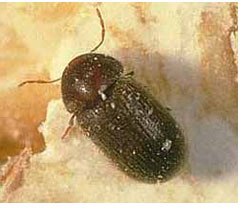 Drugstore beetles are almost identical to Cigarette beetles and are often misidentified, even by trained professionals. Fortunately, control methods are virtually the same for both insects.
Drugstore beetles are almost identical to Cigarette beetles and are often misidentified, even by trained professionals. Fortunately, control methods are virtually the same for both insects.
Drugstore beetles are 1/8-inch long, light brown to red-brown in color, and humpbacked in appearance. They differ from Cigarette beetles in that they have distinct grooves in their wing covers, whereas Cigarette beetles have smooth wing covers. Drugstore beetles feed on all types of food and spices, as well as leather, wool, hair, books, and drugs, and they readily penetrate packaging materials. There may be four generations per year in warm situations, but it is generally considered that in most homes these beetles have only one generation per year. The females lay their eggs singly in the food they are infesting. The larval period lasts about four or five months and the pual stage lasts 12 to 18 days. The complete life cycle takes about seven months.
The drugstore beetle is a cosmopolitan, junk food junkie. A more appropriate name would be the kitchen sink beetle, or the pig beetle, or better yet, the goat beetle, because they eat everything! It got its name because it can be found infesting prescription drugs. Drugstore beetles commonly feed on dried, stored products like: flour, dry mixes, chocolate, spices, dried herbs, cookies, stored grains and dried fruits and vegetables. Other edible items that this beetle has been found feeding on include: wool, leather, horns, hides, books, and wood. More amazing food items include drugs, toxins, such as strychnine powder, and tin cans! Much like wood-eating organisms, drugstore beetles contain symbiotic yeast that helps them digest these ‘food’ items. This yeast can produce complex nutrients such as B vitamins that make it possible for this beetle to eat junk.
Because they can survive with such interesting diets, an infestation can be difficult to get rid of if these beetles go unchecked for some time. Watch for accumulation of beetles at windowsills. Most samples coming into the office are from curious customers who collected adult beetles from windowsills in autumn. Look for adult beetles in stored food products regularly. Monitoring for the grubs is difficult due to their small size and secretive habits. The most common discovery of drugstore beetles in the grub stage is following the bad taste from your spoonful of morning cereal. Regularly check boxed cereals, mixes and grains, for small shot holes chewed through the sides. Look for small piles of dust and debris coming from containers and bags.
Homes infested with Drugstore beetles must be inspected carefully to determine the source of the infestation. Heavily infested materials should be discarded. Lightly infested materials may be sterilized with heat treatment. Books and manuscripts, furniture, and other infested materials that are not easily replaced may need to be fumigated to bring the beetles under control. A residual pesticide may be applied to potential harborage areas. These treatments are, however, supplementary to the clean up of infested material and should never be used as the sole means of control.